BMP4002 Business Law: Analyzing Legal Sources for UK Businesses
VerifiedAdded on 2023/06/15
|8
|2442
|68
Report
AI Summary
This report provides an overview of the key sources of law in the UK and their relevance to business organizations. It examines various legal business structures, including sole proprietorships, partnerships (general and limited liability), and incorporated businesses (private and public companies). The report discusses company law, contract law, and employment law, highlighting their impact on business operations and legal compliance. It also includes recommendations for IOM Solutions, suggesting a partnership model for expansion, emphasizing cost efficiency and investment opportunities. The analysis concludes that understanding business laws is crucial for effective and legally sound business operations in the UK.
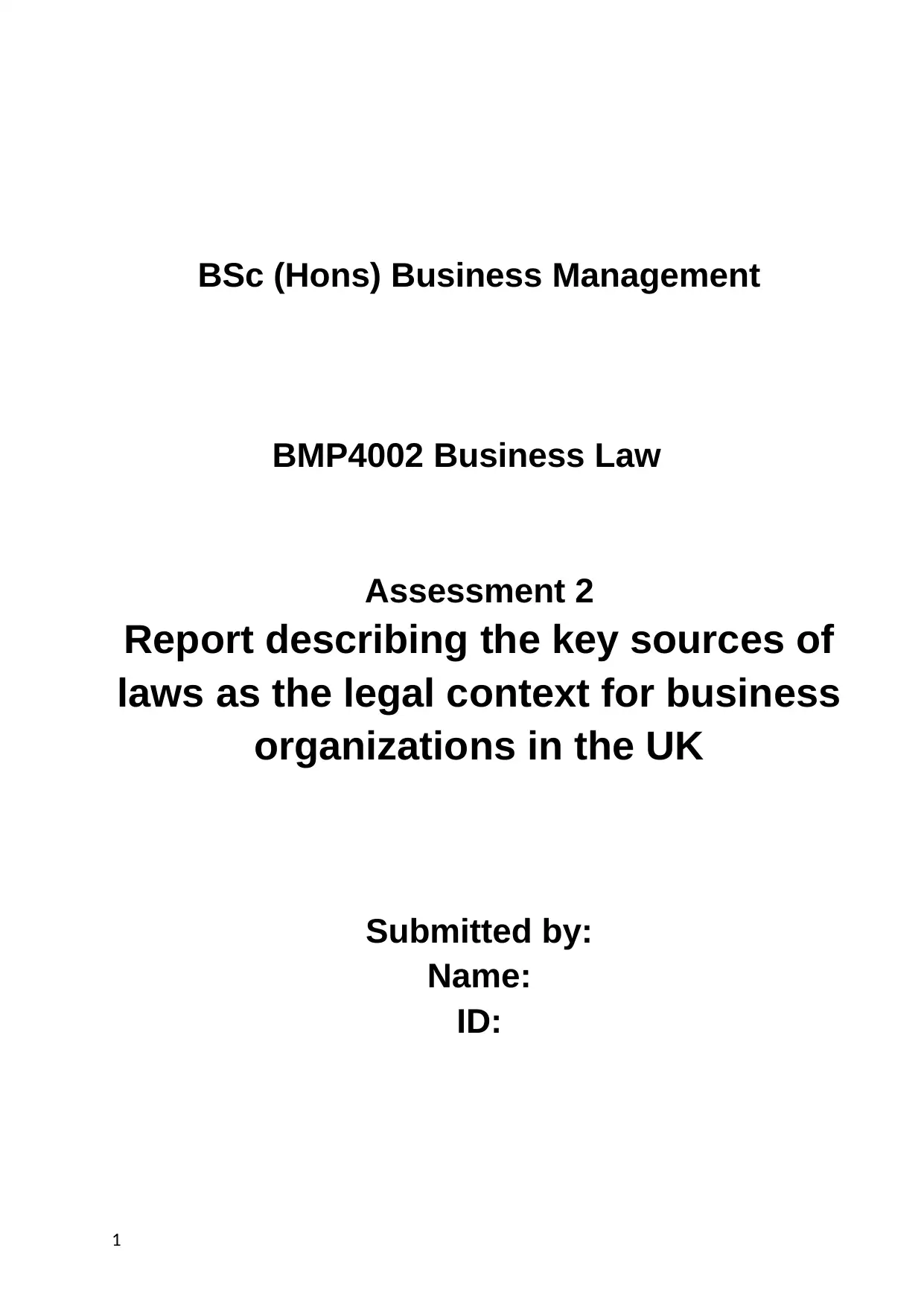
BSc (Hons) Business Management
BMP4002 Business Law
Assessment 2
Report describing the key sources of
laws as the legal context for business
organizations in the UK
Submitted by:
Name:
ID:
1
BMP4002 Business Law
Assessment 2
Report describing the key sources of
laws as the legal context for business
organizations in the UK
Submitted by:
Name:
ID:
1
Paraphrase This Document
Need a fresh take? Get an instant paraphrase of this document with our AI Paraphraser
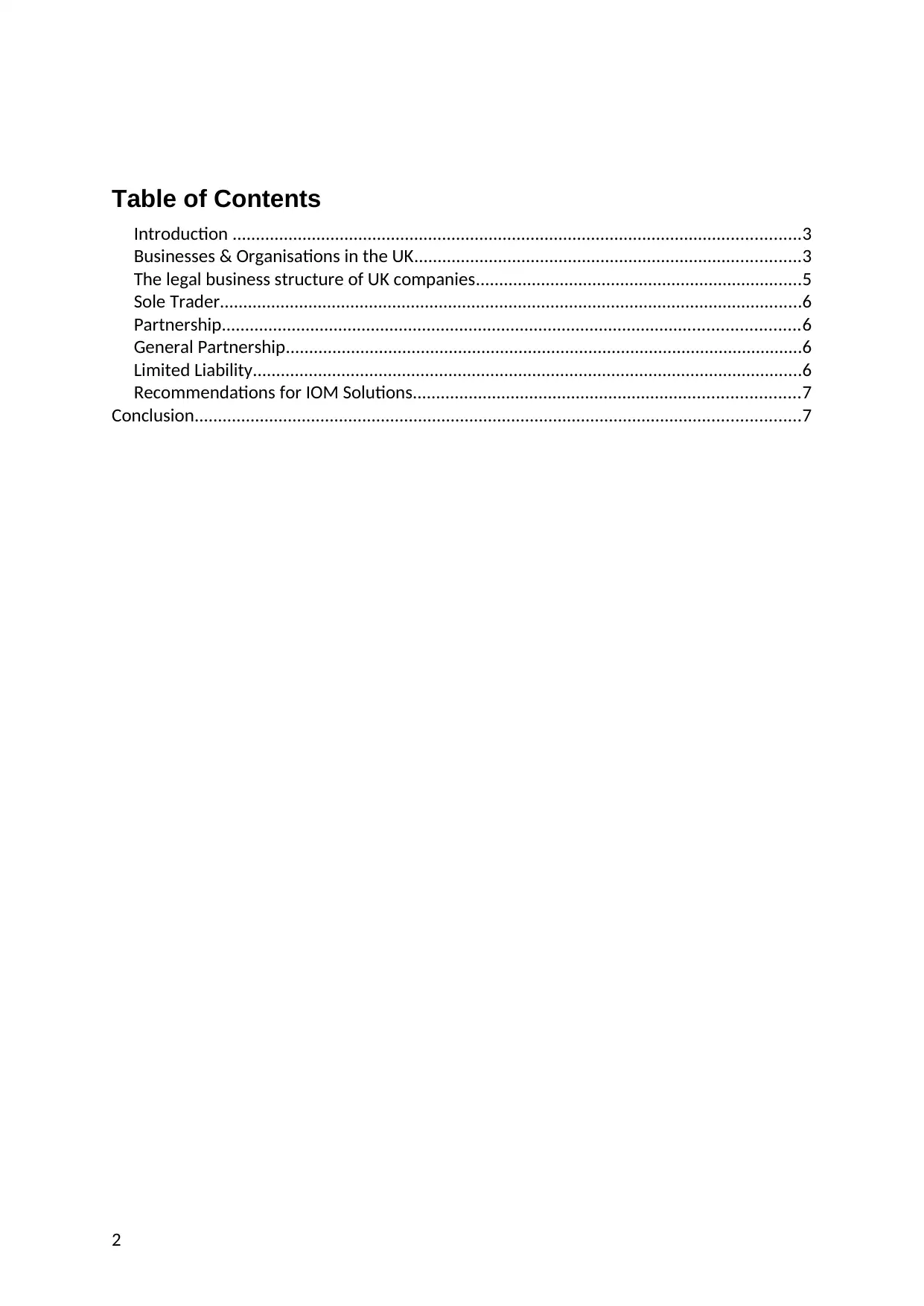
Table of Contents
Introduction ..........................................................................................................................3
Businesses & Organisations in the UK...................................................................................3
The legal business structure of UK companies......................................................................5
Sole Trader.............................................................................................................................6
Partnership............................................................................................................................6
General Partnership...............................................................................................................6
Limited Liability......................................................................................................................6
Recommendations for IOM Solutions...................................................................................7
Conclusion..................................................................................................................................7
2
Introduction ..........................................................................................................................3
Businesses & Organisations in the UK...................................................................................3
The legal business structure of UK companies......................................................................5
Sole Trader.............................................................................................................................6
Partnership............................................................................................................................6
General Partnership...............................................................................................................6
Limited Liability......................................................................................................................6
Recommendations for IOM Solutions...................................................................................7
Conclusion..................................................................................................................................7
2
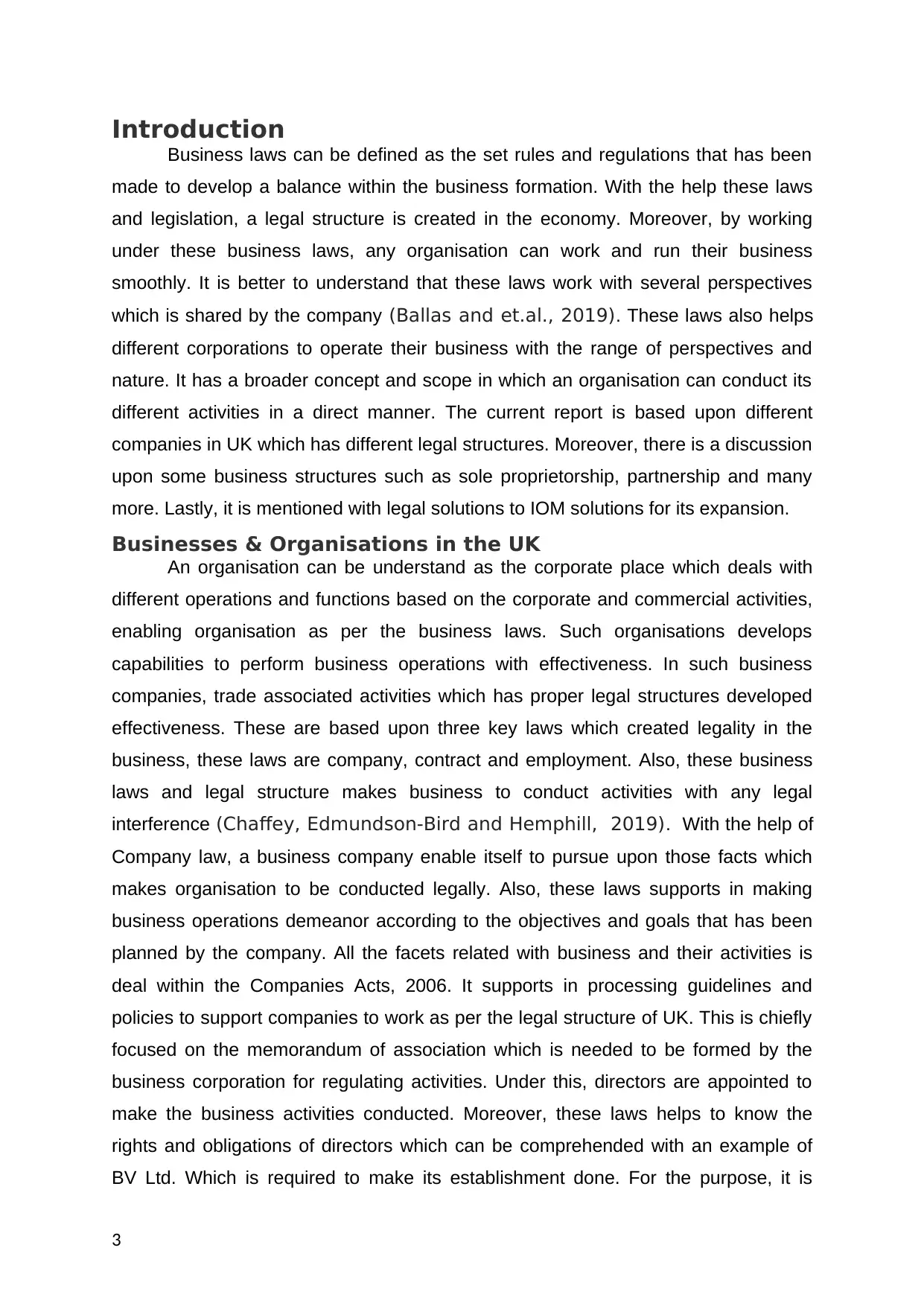
Introduction
Business laws can be defined as the set rules and regulations that has been
made to develop a balance within the business formation. With the help these laws
and legislation, a legal structure is created in the economy. Moreover, by working
under these business laws, any organisation can work and run their business
smoothly. It is better to understand that these laws work with several perspectives
which is shared by the company (Ballas and et.al., 2019). These laws also helps
different corporations to operate their business with the range of perspectives and
nature. It has a broader concept and scope in which an organisation can conduct its
different activities in a direct manner. The current report is based upon different
companies in UK which has different legal structures. Moreover, there is a discussion
upon some business structures such as sole proprietorship, partnership and many
more. Lastly, it is mentioned with legal solutions to IOM solutions for its expansion.
Businesses & Organisations in the UK
An organisation can be understand as the corporate place which deals with
different operations and functions based on the corporate and commercial activities,
enabling organisation as per the business laws. Such organisations develops
capabilities to perform business operations with effectiveness. In such business
companies, trade associated activities which has proper legal structures developed
effectiveness. These are based upon three key laws which created legality in the
business, these laws are company, contract and employment. Also, these business
laws and legal structure makes business to conduct activities with any legal
interference (Chaffey, Edmundson-Bird and Hemphill, 2019). With the help of
Company law, a business company enable itself to pursue upon those facts which
makes organisation to be conducted legally. Also, these laws supports in making
business operations demeanor according to the objectives and goals that has been
planned by the company. All the facets related with business and their activities is
deal within the Companies Acts, 2006. It supports in processing guidelines and
policies to support companies to work as per the legal structure of UK. This is chiefly
focused on the memorandum of association which is needed to be formed by the
business corporation for regulating activities. Under this, directors are appointed to
make the business activities conducted. Moreover, these laws helps to know the
rights and obligations of directors which can be comprehended with an example of
BV Ltd. Which is required to make its establishment done. For the purpose, it is
3
Business laws can be defined as the set rules and regulations that has been
made to develop a balance within the business formation. With the help these laws
and legislation, a legal structure is created in the economy. Moreover, by working
under these business laws, any organisation can work and run their business
smoothly. It is better to understand that these laws work with several perspectives
which is shared by the company (Ballas and et.al., 2019). These laws also helps
different corporations to operate their business with the range of perspectives and
nature. It has a broader concept and scope in which an organisation can conduct its
different activities in a direct manner. The current report is based upon different
companies in UK which has different legal structures. Moreover, there is a discussion
upon some business structures such as sole proprietorship, partnership and many
more. Lastly, it is mentioned with legal solutions to IOM solutions for its expansion.
Businesses & Organisations in the UK
An organisation can be understand as the corporate place which deals with
different operations and functions based on the corporate and commercial activities,
enabling organisation as per the business laws. Such organisations develops
capabilities to perform business operations with effectiveness. In such business
companies, trade associated activities which has proper legal structures developed
effectiveness. These are based upon three key laws which created legality in the
business, these laws are company, contract and employment. Also, these business
laws and legal structure makes business to conduct activities with any legal
interference (Chaffey, Edmundson-Bird and Hemphill, 2019). With the help of
Company law, a business company enable itself to pursue upon those facts which
makes organisation to be conducted legally. Also, these laws supports in making
business operations demeanor according to the objectives and goals that has been
planned by the company. All the facets related with business and their activities is
deal within the Companies Acts, 2006. It supports in processing guidelines and
policies to support companies to work as per the legal structure of UK. This is chiefly
focused on the memorandum of association which is needed to be formed by the
business corporation for regulating activities. Under this, directors are appointed to
make the business activities conducted. Moreover, these laws helps to know the
rights and obligations of directors which can be comprehended with an example of
BV Ltd. Which is required to make its establishment done. For the purpose, it is
3
⊘ This is a preview!⊘
Do you want full access?
Subscribe today to unlock all pages.

Trusted by 1+ million students worldwide
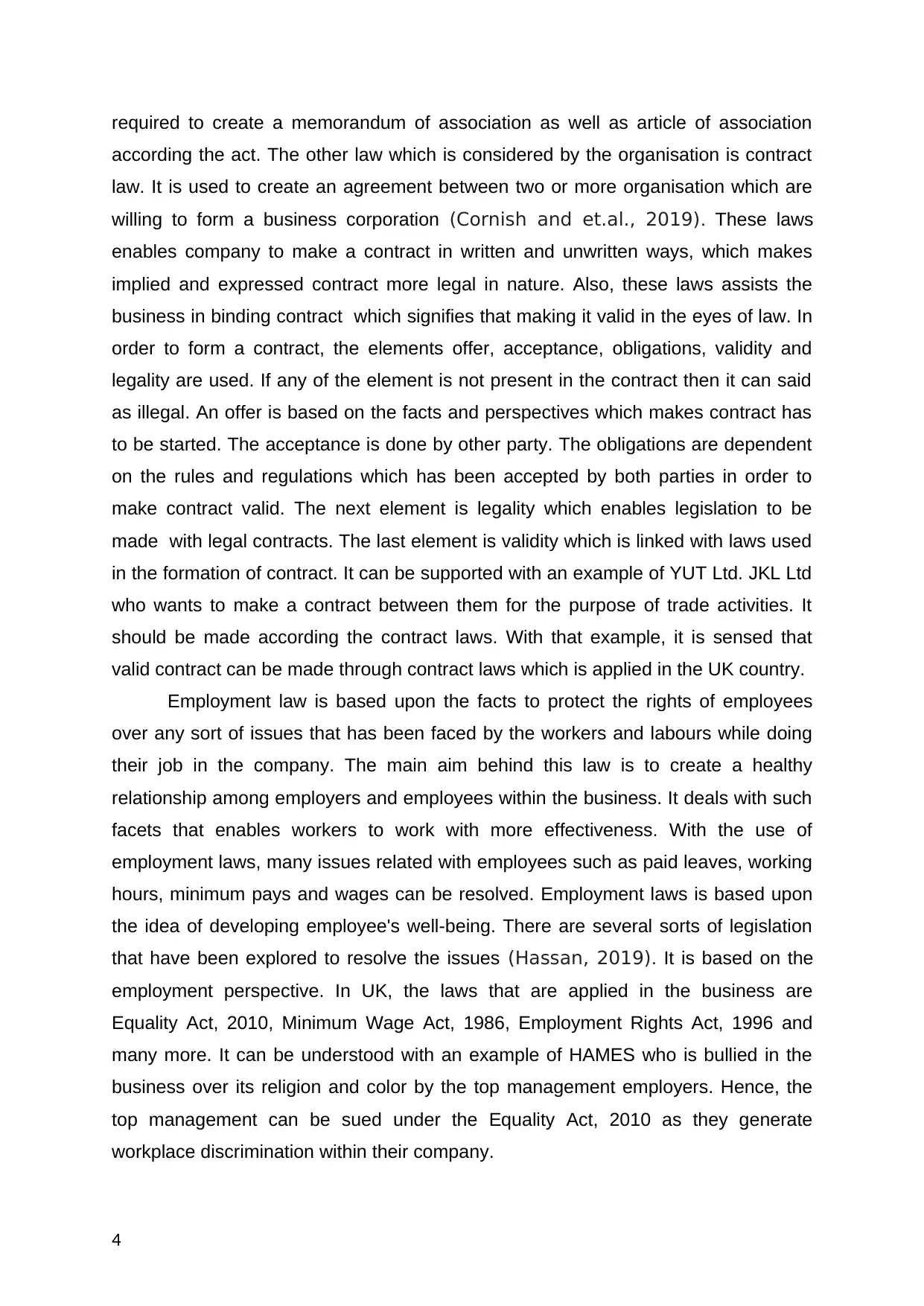
required to create a memorandum of association as well as article of association
according the act. The other law which is considered by the organisation is contract
law. It is used to create an agreement between two or more organisation which are
willing to form a business corporation (Cornish and et.al., 2019). These laws
enables company to make a contract in written and unwritten ways, which makes
implied and expressed contract more legal in nature. Also, these laws assists the
business in binding contract which signifies that making it valid in the eyes of law. In
order to form a contract, the elements offer, acceptance, obligations, validity and
legality are used. If any of the element is not present in the contract then it can said
as illegal. An offer is based on the facts and perspectives which makes contract has
to be started. The acceptance is done by other party. The obligations are dependent
on the rules and regulations which has been accepted by both parties in order to
make contract valid. The next element is legality which enables legislation to be
made with legal contracts. The last element is validity which is linked with laws used
in the formation of contract. It can be supported with an example of YUT Ltd. JKL Ltd
who wants to make a contract between them for the purpose of trade activities. It
should be made according the contract laws. With that example, it is sensed that
valid contract can be made through contract laws which is applied in the UK country.
Employment law is based upon the facts to protect the rights of employees
over any sort of issues that has been faced by the workers and labours while doing
their job in the company. The main aim behind this law is to create a healthy
relationship among employers and employees within the business. It deals with such
facets that enables workers to work with more effectiveness. With the use of
employment laws, many issues related with employees such as paid leaves, working
hours, minimum pays and wages can be resolved. Employment laws is based upon
the idea of developing employee's well-being. There are several sorts of legislation
that have been explored to resolve the issues (Hassan, 2019). It is based on the
employment perspective. In UK, the laws that are applied in the business are
Equality Act, 2010, Minimum Wage Act, 1986, Employment Rights Act, 1996 and
many more. It can be understood with an example of HAMES who is bullied in the
business over its religion and color by the top management employers. Hence, the
top management can be sued under the Equality Act, 2010 as they generate
workplace discrimination within their company.
4
according the act. The other law which is considered by the organisation is contract
law. It is used to create an agreement between two or more organisation which are
willing to form a business corporation (Cornish and et.al., 2019). These laws
enables company to make a contract in written and unwritten ways, which makes
implied and expressed contract more legal in nature. Also, these laws assists the
business in binding contract which signifies that making it valid in the eyes of law. In
order to form a contract, the elements offer, acceptance, obligations, validity and
legality are used. If any of the element is not present in the contract then it can said
as illegal. An offer is based on the facts and perspectives which makes contract has
to be started. The acceptance is done by other party. The obligations are dependent
on the rules and regulations which has been accepted by both parties in order to
make contract valid. The next element is legality which enables legislation to be
made with legal contracts. The last element is validity which is linked with laws used
in the formation of contract. It can be supported with an example of YUT Ltd. JKL Ltd
who wants to make a contract between them for the purpose of trade activities. It
should be made according the contract laws. With that example, it is sensed that
valid contract can be made through contract laws which is applied in the UK country.
Employment law is based upon the facts to protect the rights of employees
over any sort of issues that has been faced by the workers and labours while doing
their job in the company. The main aim behind this law is to create a healthy
relationship among employers and employees within the business. It deals with such
facets that enables workers to work with more effectiveness. With the use of
employment laws, many issues related with employees such as paid leaves, working
hours, minimum pays and wages can be resolved. Employment laws is based upon
the idea of developing employee's well-being. There are several sorts of legislation
that have been explored to resolve the issues (Hassan, 2019). It is based on the
employment perspective. In UK, the laws that are applied in the business are
Equality Act, 2010, Minimum Wage Act, 1986, Employment Rights Act, 1996 and
many more. It can be understood with an example of HAMES who is bullied in the
business over its religion and color by the top management employers. Hence, the
top management can be sued under the Equality Act, 2010 as they generate
workplace discrimination within their company.
4
Paraphrase This Document
Need a fresh take? Get an instant paraphrase of this document with our AI Paraphraser
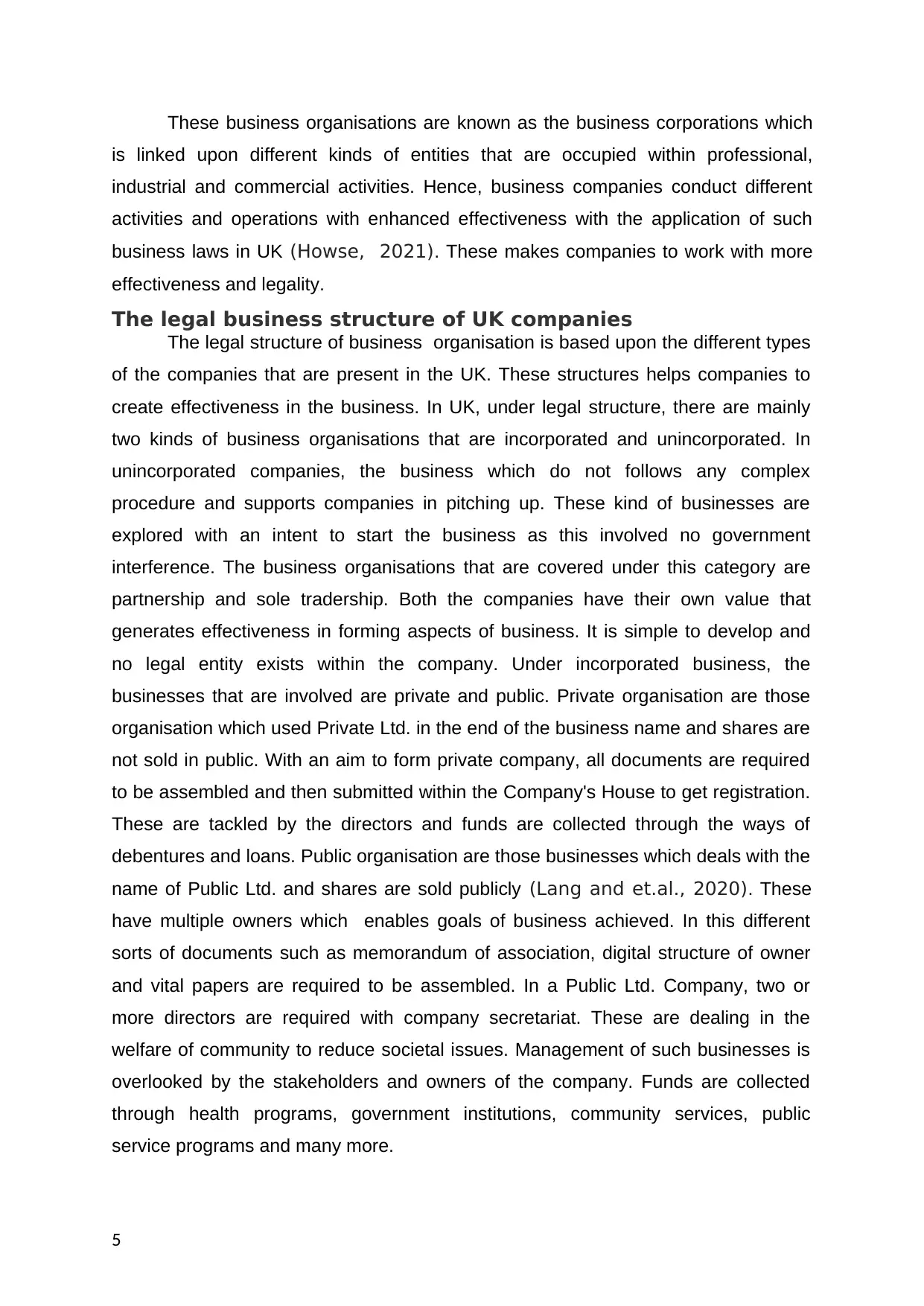
These business organisations are known as the business corporations which
is linked upon different kinds of entities that are occupied within professional,
industrial and commercial activities. Hence, business companies conduct different
activities and operations with enhanced effectiveness with the application of such
business laws in UK (Howse, 2021). These makes companies to work with more
effectiveness and legality.
The legal business structure of UK companies
The legal structure of business organisation is based upon the different types
of the companies that are present in the UK. These structures helps companies to
create effectiveness in the business. In UK, under legal structure, there are mainly
two kinds of business organisations that are incorporated and unincorporated. In
unincorporated companies, the business which do not follows any complex
procedure and supports companies in pitching up. These kind of businesses are
explored with an intent to start the business as this involved no government
interference. The business organisations that are covered under this category are
partnership and sole tradership. Both the companies have their own value that
generates effectiveness in forming aspects of business. It is simple to develop and
no legal entity exists within the company. Under incorporated business, the
businesses that are involved are private and public. Private organisation are those
organisation which used Private Ltd. in the end of the business name and shares are
not sold in public. With an aim to form private company, all documents are required
to be assembled and then submitted within the Company's House to get registration.
These are tackled by the directors and funds are collected through the ways of
debentures and loans. Public organisation are those businesses which deals with the
name of Public Ltd. and shares are sold publicly (Lang and et.al., 2020). These
have multiple owners which enables goals of business achieved. In this different
sorts of documents such as memorandum of association, digital structure of owner
and vital papers are required to be assembled. In a Public Ltd. Company, two or
more directors are required with company secretariat. These are dealing in the
welfare of community to reduce societal issues. Management of such businesses is
overlooked by the stakeholders and owners of the company. Funds are collected
through health programs, government institutions, community services, public
service programs and many more.
5
is linked upon different kinds of entities that are occupied within professional,
industrial and commercial activities. Hence, business companies conduct different
activities and operations with enhanced effectiveness with the application of such
business laws in UK (Howse, 2021). These makes companies to work with more
effectiveness and legality.
The legal business structure of UK companies
The legal structure of business organisation is based upon the different types
of the companies that are present in the UK. These structures helps companies to
create effectiveness in the business. In UK, under legal structure, there are mainly
two kinds of business organisations that are incorporated and unincorporated. In
unincorporated companies, the business which do not follows any complex
procedure and supports companies in pitching up. These kind of businesses are
explored with an intent to start the business as this involved no government
interference. The business organisations that are covered under this category are
partnership and sole tradership. Both the companies have their own value that
generates effectiveness in forming aspects of business. It is simple to develop and
no legal entity exists within the company. Under incorporated business, the
businesses that are involved are private and public. Private organisation are those
organisation which used Private Ltd. in the end of the business name and shares are
not sold in public. With an aim to form private company, all documents are required
to be assembled and then submitted within the Company's House to get registration.
These are tackled by the directors and funds are collected through the ways of
debentures and loans. Public organisation are those businesses which deals with the
name of Public Ltd. and shares are sold publicly (Lang and et.al., 2020). These
have multiple owners which enables goals of business achieved. In this different
sorts of documents such as memorandum of association, digital structure of owner
and vital papers are required to be assembled. In a Public Ltd. Company, two or
more directors are required with company secretariat. These are dealing in the
welfare of community to reduce societal issues. Management of such businesses is
overlooked by the stakeholders and owners of the company. Funds are collected
through health programs, government institutions, community services, public
service programs and many more.
5
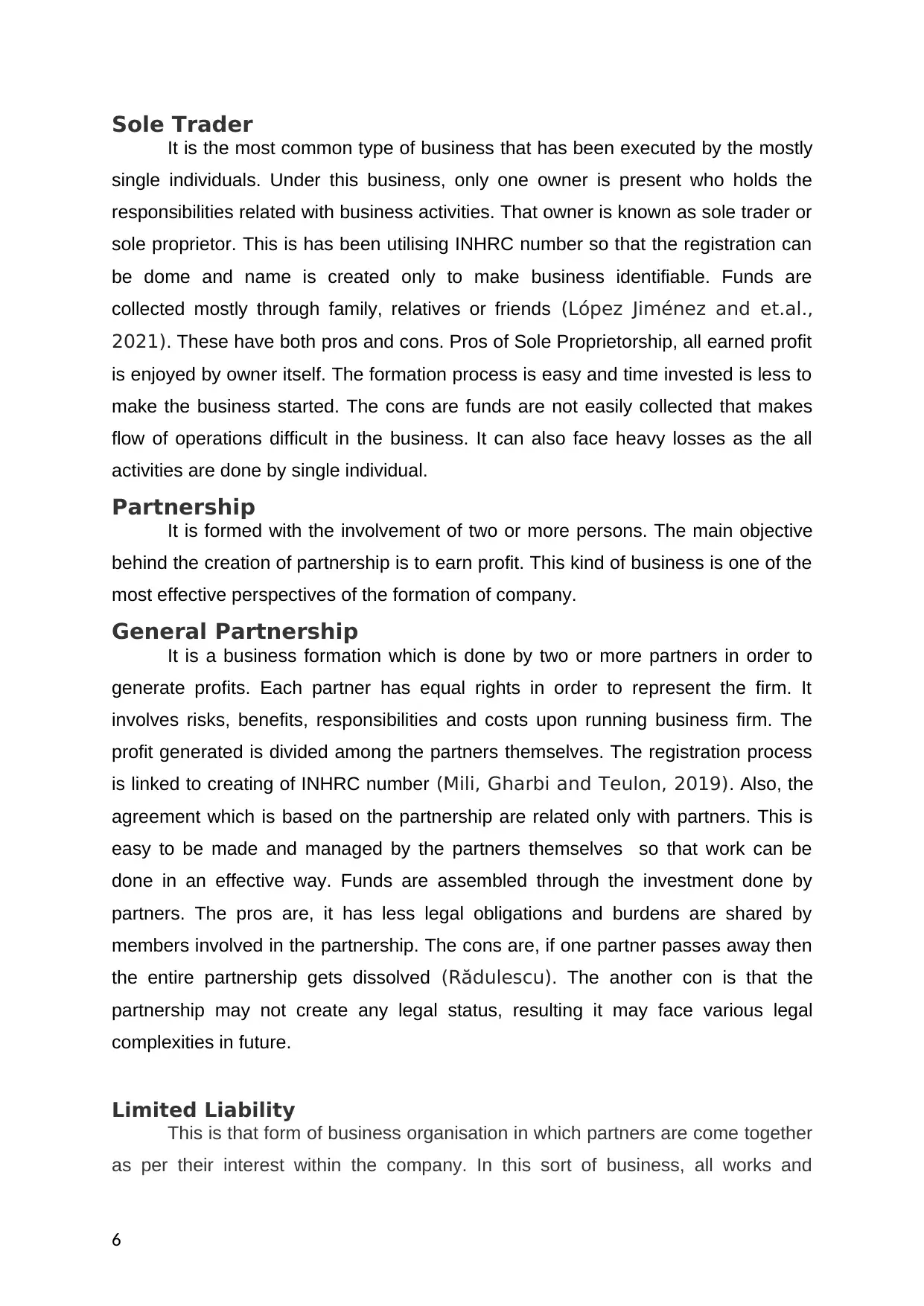
Sole Trader
It is the most common type of business that has been executed by the mostly
single individuals. Under this business, only one owner is present who holds the
responsibilities related with business activities. That owner is known as sole trader or
sole proprietor. This is has been utilising INHRC number so that the registration can
be dome and name is created only to make business identifiable. Funds are
collected mostly through family, relatives or friends (López Jiménez and et.al.,
2021). These have both pros and cons. Pros of Sole Proprietorship, all earned profit
is enjoyed by owner itself. The formation process is easy and time invested is less to
make the business started. The cons are funds are not easily collected that makes
flow of operations difficult in the business. It can also face heavy losses as the all
activities are done by single individual.
Partnership
It is formed with the involvement of two or more persons. The main objective
behind the creation of partnership is to earn profit. This kind of business is one of the
most effective perspectives of the formation of company.
General Partnership
It is a business formation which is done by two or more partners in order to
generate profits. Each partner has equal rights in order to represent the firm. It
involves risks, benefits, responsibilities and costs upon running business firm. The
profit generated is divided among the partners themselves. The registration process
is linked to creating of INHRC number (Mili, Gharbi and Teulon, 2019). Also, the
agreement which is based on the partnership are related only with partners. This is
easy to be made and managed by the partners themselves so that work can be
done in an effective way. Funds are assembled through the investment done by
partners. The pros are, it has less legal obligations and burdens are shared by
members involved in the partnership. The cons are, if one partner passes away then
the entire partnership gets dissolved (Rădulescu). The another con is that the
partnership may not create any legal status, resulting it may face various legal
complexities in future.
Limited Liability
This is that form of business organisation in which partners are come together
as per their interest within the company. In this sort of business, all works and
6
It is the most common type of business that has been executed by the mostly
single individuals. Under this business, only one owner is present who holds the
responsibilities related with business activities. That owner is known as sole trader or
sole proprietor. This is has been utilising INHRC number so that the registration can
be dome and name is created only to make business identifiable. Funds are
collected mostly through family, relatives or friends (López Jiménez and et.al.,
2021). These have both pros and cons. Pros of Sole Proprietorship, all earned profit
is enjoyed by owner itself. The formation process is easy and time invested is less to
make the business started. The cons are funds are not easily collected that makes
flow of operations difficult in the business. It can also face heavy losses as the all
activities are done by single individual.
Partnership
It is formed with the involvement of two or more persons. The main objective
behind the creation of partnership is to earn profit. This kind of business is one of the
most effective perspectives of the formation of company.
General Partnership
It is a business formation which is done by two or more partners in order to
generate profits. Each partner has equal rights in order to represent the firm. It
involves risks, benefits, responsibilities and costs upon running business firm. The
profit generated is divided among the partners themselves. The registration process
is linked to creating of INHRC number (Mili, Gharbi and Teulon, 2019). Also, the
agreement which is based on the partnership are related only with partners. This is
easy to be made and managed by the partners themselves so that work can be
done in an effective way. Funds are assembled through the investment done by
partners. The pros are, it has less legal obligations and burdens are shared by
members involved in the partnership. The cons are, if one partner passes away then
the entire partnership gets dissolved (Rădulescu). The another con is that the
partnership may not create any legal status, resulting it may face various legal
complexities in future.
Limited Liability
This is that form of business organisation in which partners are come together
as per their interest within the company. In this sort of business, all works and
6
⊘ This is a preview!⊘
Do you want full access?
Subscribe today to unlock all pages.

Trusted by 1+ million students worldwide

dealings are handled according to the investment that is generated by the partners
themselves. Also, all the partners in the limited liability partnership have limited
liabilities. Each member is curbed against other members financial and legal
mistakes (Pronyaeva and Fedotenkova, 2020). The pros are profit generation
helps to business to run smoothly and effectively. It helps to create coordination
among partners. The con is that if the members involves in the business are not
interested in spending money then the business is not be able to run.
Recommendations for IOM Solutions
It is recommended after analysing all the facets and perspectives of different
business organisations and its related legal structure is that for IOM solutions, it can
opt for partnership business which helps business to run smoothly and it is also
effective to expand business as the member brings investment in the business. It
enables cost efficiency in the business.
Conclusion
On the basis of above discussion, it has been concluded that business laws
helps business corporations to run their business in the most effective and smooth
way. With the help of business laws, operations and functions of business can be
done effectively and legal structure can also be generated for the business. In the
above discussion, there are range of business organisations are discussed such as
sole proprietorship, partnership, limited liabilities and many more. It is discussed with
pros and cons in order to identify which is best appropriate to go for.
7
themselves. Also, all the partners in the limited liability partnership have limited
liabilities. Each member is curbed against other members financial and legal
mistakes (Pronyaeva and Fedotenkova, 2020). The pros are profit generation
helps to business to run smoothly and effectively. It helps to create coordination
among partners. The con is that if the members involves in the business are not
interested in spending money then the business is not be able to run.
Recommendations for IOM Solutions
It is recommended after analysing all the facets and perspectives of different
business organisations and its related legal structure is that for IOM solutions, it can
opt for partnership business which helps business to run smoothly and it is also
effective to expand business as the member brings investment in the business. It
enables cost efficiency in the business.
Conclusion
On the basis of above discussion, it has been concluded that business laws
helps business corporations to run their business in the most effective and smooth
way. With the help of business laws, operations and functions of business can be
done effectively and legal structure can also be generated for the business. In the
above discussion, there are range of business organisations are discussed such as
sole proprietorship, partnership, limited liabilities and many more. It is discussed with
pros and cons in order to identify which is best appropriate to go for.
7
Paraphrase This Document
Need a fresh take? Get an instant paraphrase of this document with our AI Paraphraser
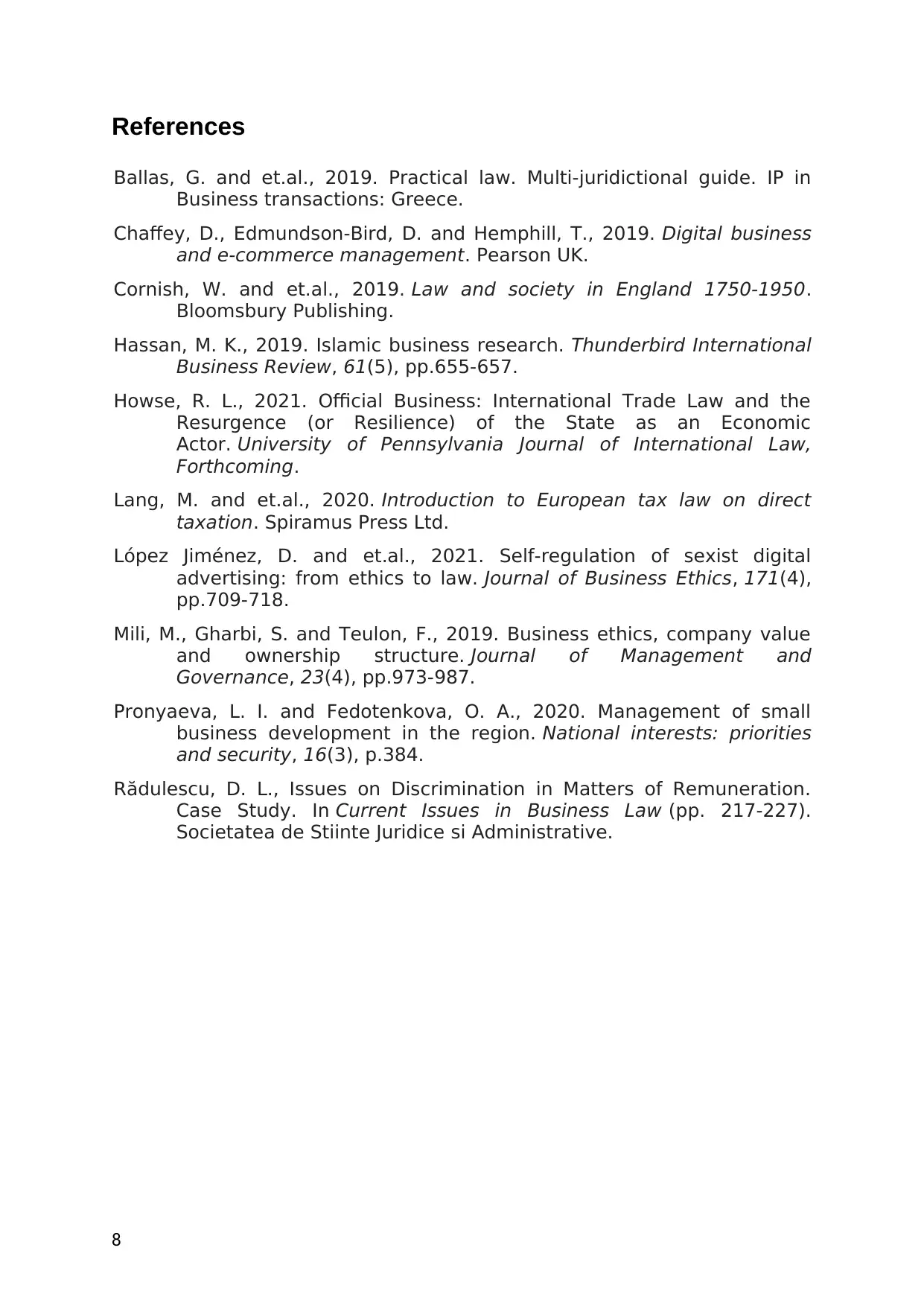
References
Ballas, G. and et.al., 2019. Practical law. Multi-juridictional guide. IP in
Business transactions: Greece.
Chaffey, D., Edmundson-Bird, D. and Hemphill, T., 2019. Digital business
and e-commerce management. Pearson UK.
Cornish, W. and et.al., 2019. Law and society in England 1750-1950.
Bloomsbury Publishing.
Hassan, M. K., 2019. Islamic business research. Thunderbird International
Business Review, 61(5), pp.655-657.
Howse, R. L., 2021. Official Business: International Trade Law and the
Resurgence (or Resilience) of the State as an Economic
Actor. University of Pennsylvania Journal of International Law,
Forthcoming.
Lang, M. and et.al., 2020. Introduction to European tax law on direct
taxation. Spiramus Press Ltd.
López Jiménez, D. and et.al., 2021. Self-regulation of sexist digital
advertising: from ethics to law. Journal of Business Ethics, 171(4),
pp.709-718.
Mili, M., Gharbi, S. and Teulon, F., 2019. Business ethics, company value
and ownership structure. Journal of Management and
Governance, 23(4), pp.973-987.
Pronyaeva, L. I. and Fedotenkova, O. A., 2020. Management of small
business development in the region. National interests: priorities
and security, 16(3), p.384.
Rădulescu, D. L., Issues on Discrimination in Matters of Remuneration.
Case Study. In Current Issues in Business Law (pp. 217-227).
Societatea de Stiinte Juridice si Administrative.
8
Ballas, G. and et.al., 2019. Practical law. Multi-juridictional guide. IP in
Business transactions: Greece.
Chaffey, D., Edmundson-Bird, D. and Hemphill, T., 2019. Digital business
and e-commerce management. Pearson UK.
Cornish, W. and et.al., 2019. Law and society in England 1750-1950.
Bloomsbury Publishing.
Hassan, M. K., 2019. Islamic business research. Thunderbird International
Business Review, 61(5), pp.655-657.
Howse, R. L., 2021. Official Business: International Trade Law and the
Resurgence (or Resilience) of the State as an Economic
Actor. University of Pennsylvania Journal of International Law,
Forthcoming.
Lang, M. and et.al., 2020. Introduction to European tax law on direct
taxation. Spiramus Press Ltd.
López Jiménez, D. and et.al., 2021. Self-regulation of sexist digital
advertising: from ethics to law. Journal of Business Ethics, 171(4),
pp.709-718.
Mili, M., Gharbi, S. and Teulon, F., 2019. Business ethics, company value
and ownership structure. Journal of Management and
Governance, 23(4), pp.973-987.
Pronyaeva, L. I. and Fedotenkova, O. A., 2020. Management of small
business development in the region. National interests: priorities
and security, 16(3), p.384.
Rădulescu, D. L., Issues on Discrimination in Matters of Remuneration.
Case Study. In Current Issues in Business Law (pp. 217-227).
Societatea de Stiinte Juridice si Administrative.
8
1 out of 8
Related Documents
Your All-in-One AI-Powered Toolkit for Academic Success.
+13062052269
info@desklib.com
Available 24*7 on WhatsApp / Email
![[object Object]](/_next/static/media/star-bottom.7253800d.svg)
Unlock your academic potential
Copyright © 2020–2025 A2Z Services. All Rights Reserved. Developed and managed by ZUCOL.
